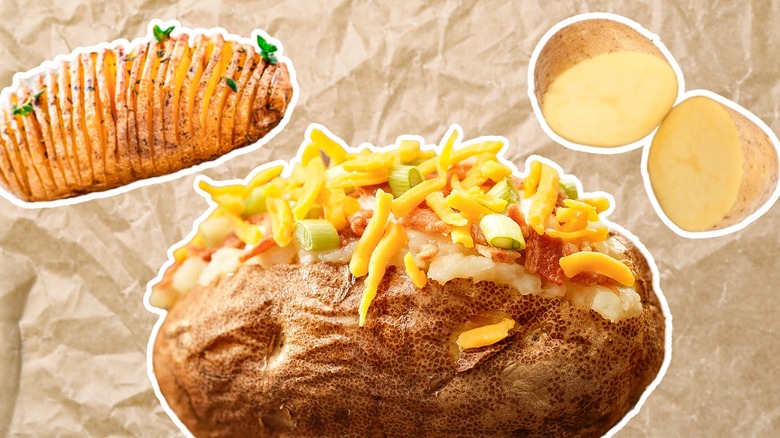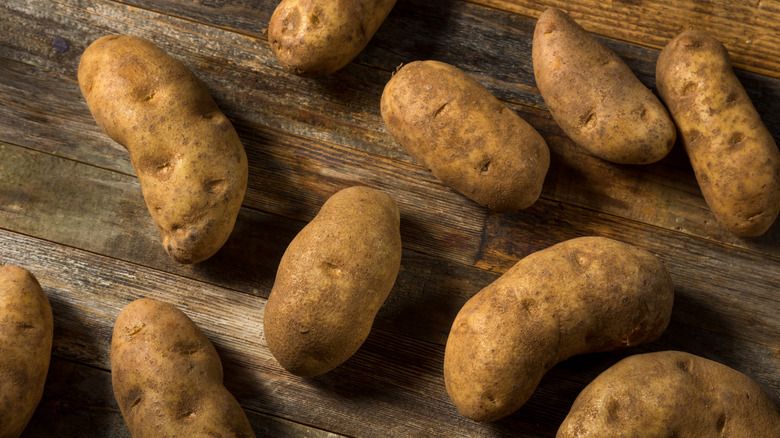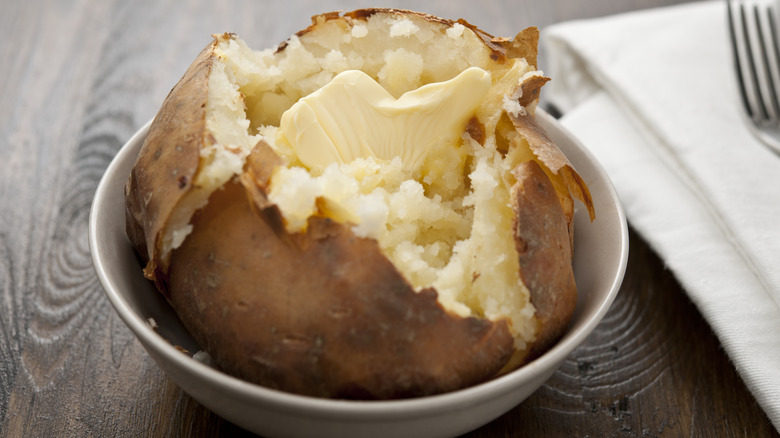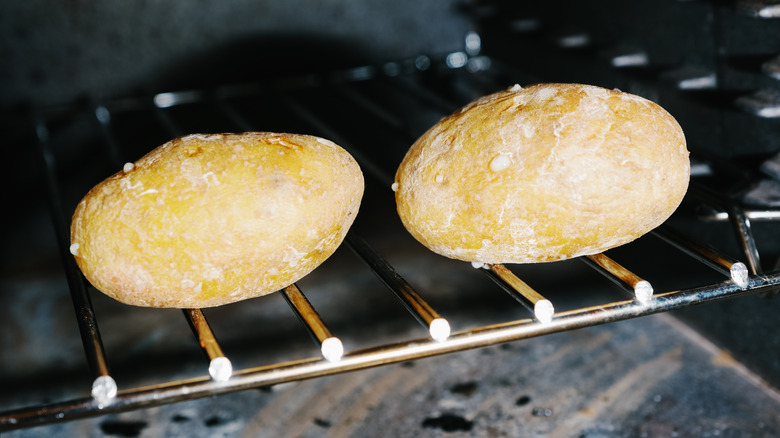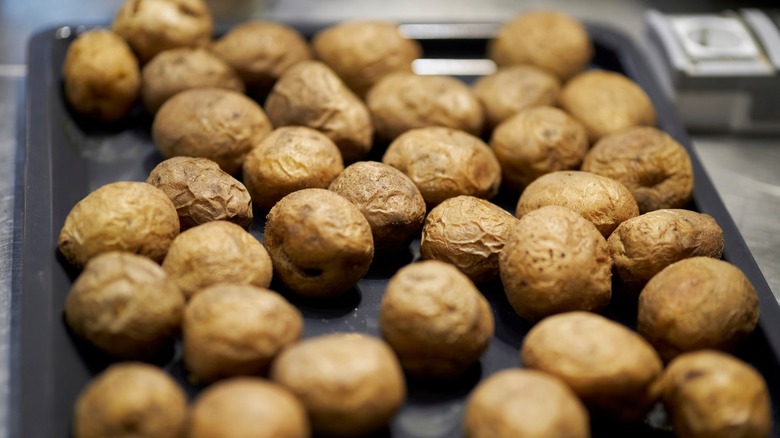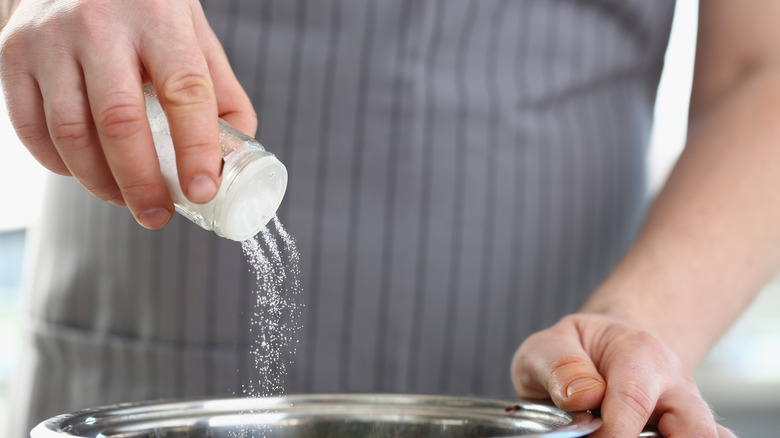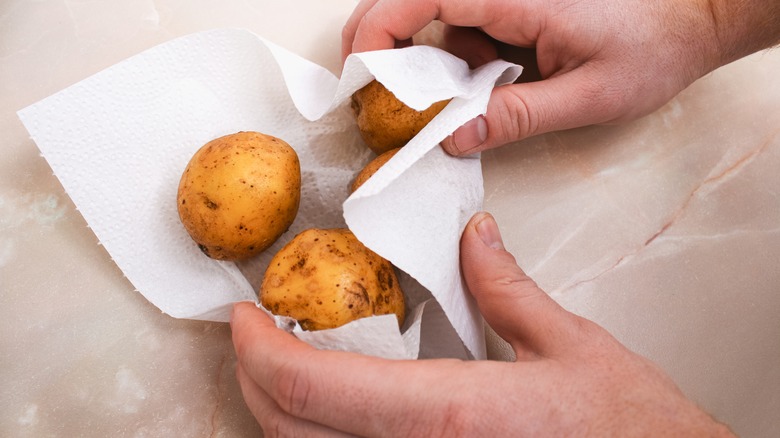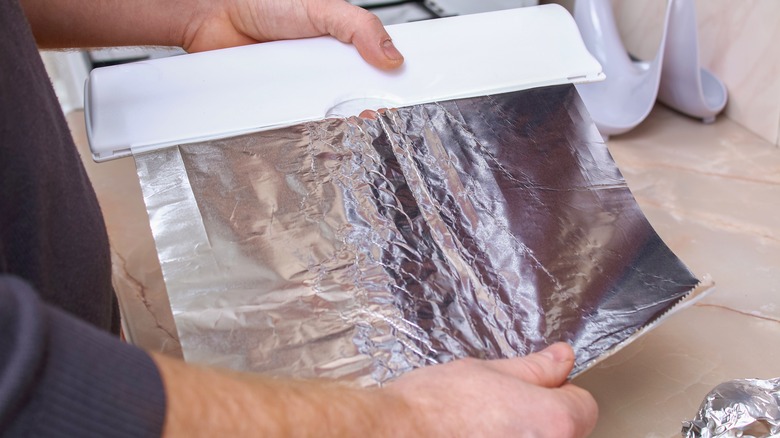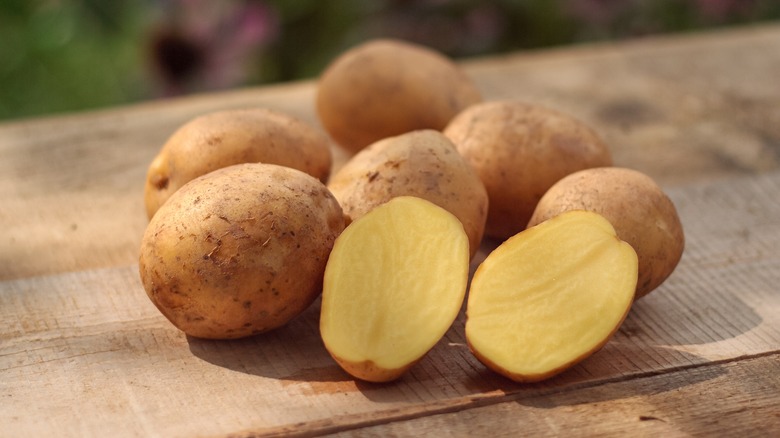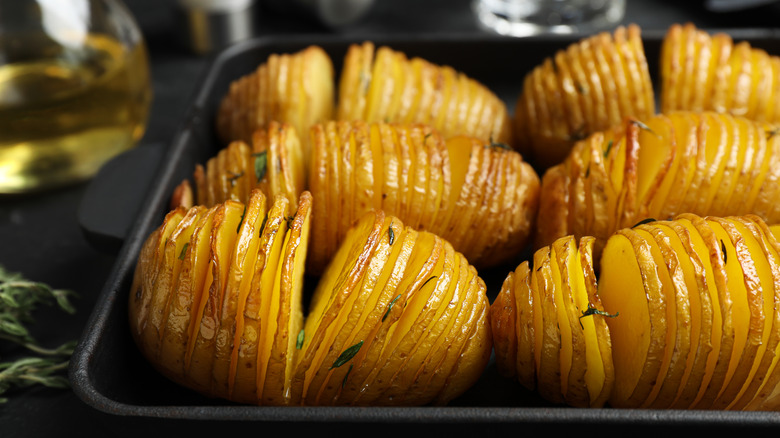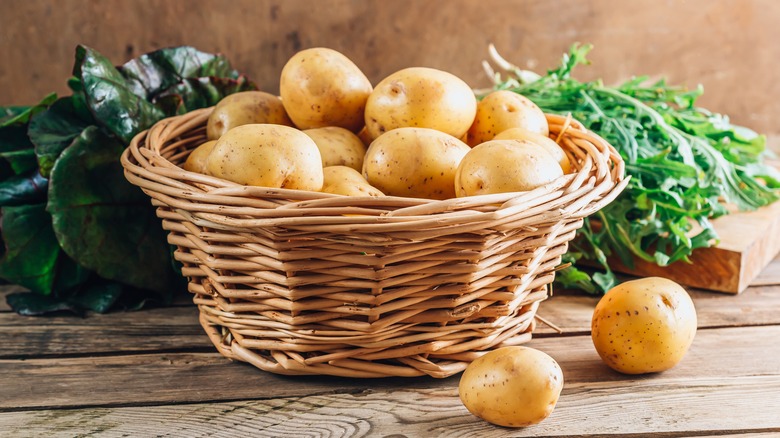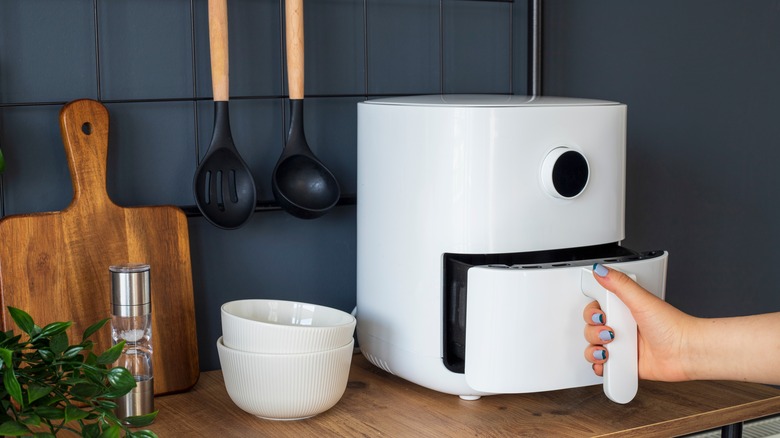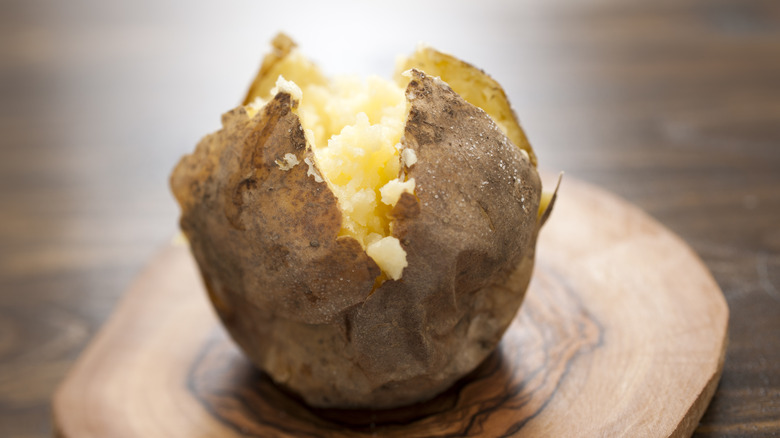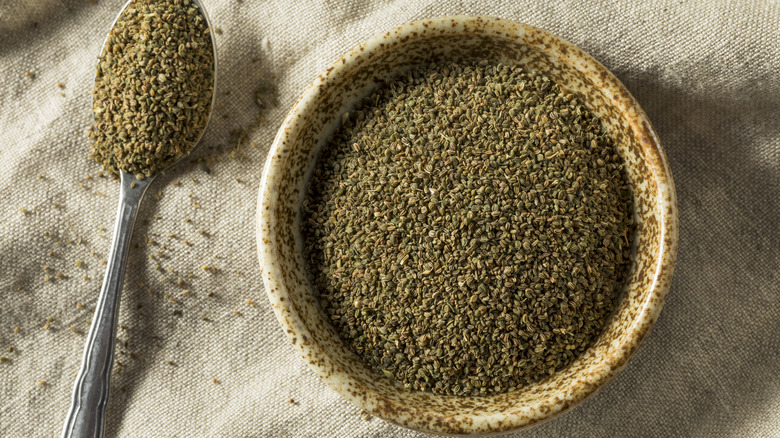14 Ways To Add More Crunch To Baked Potatoes
Baked potatoes are generally a crowd-pleaser, and for good reason. They're easy to make, they can be enjoyed by people who follow specific diets, including gluten-free and vegan, and they're infinitely customizable. There's just one problem: All too often, they come out of the oven or microwave soggy, which can quickly turn a crowd-pleaser into a dinner party pariah.
Fortunately, there are any number of toppings that can come to the rescue in these situations, including diced jalapeños, crispy bacon — even tortilla chips. But why resort to a quick fix when you can go straight to the root of the problem? How you prepare them, what you bake them on, and even the type of spud you use can determine how crunchy your baked potato will be before it even goes into the oven.
And texture isn't the only reason to strive for a crisp baked potato. There are more nutrients in the skin of a potato than the inside of a potato. In fact, about half of a potato's fiber comes from the skin, which is all the more reason to learn how to make it as appealing as possible. Here are a few ways you can add that extra crispiness to your next batch of baked potatoes.
Use russet potatoes
Whether or not you know them by name, russet potatoes are most likely what come to mind when you think of baked potatoes. Aptly named for the reddish-brown color of their skins, these oblong tubers have the white or light-yellow interior you expect when you cut into a baked spud. Russets are both widely available and perfect for baked potatoes, mashed potatoes, and French fries alike, which is probably why Americans seem to prefer them over other potato varieties.
Because their skins have high starch content, which naturally helps to seal in moisture, russets are the ideal potatoes for baking. When a potato is baked, the moisture in the potato is absorbed by the grains beneath the skin, causing them to expand and separate into the delightfully fluffy texture we all know and love. The bonding process between the starch and grain (also known as gelatinization) that happens during baking simultaneously dehydrates the skin of the potato, which is what allows russets to crisp up so beautifully in the oven.
Score them before baking
If you're an avid potato baker, you've probably heard that you should poke holes in your potato with a fork before popping it in the oven to allow steam to escape and to lower the risk of your potato bursting while it bakes. But have you tried scoring it instead? This British technique, which is often used in bread baking, serves the same purpose: It lets out steam and prevents a dinnertime disaster. The key difference when baking a scored potato is that steam escapes through the open top of the potato instead of through the skin, giving the exterior the opportunity to get extra crunchy.
Scoring a potato before baking it for perfectly crisp jacket potatoes, as they're called across the pond, couldn't be easier. Simply cut an X about a quarter of an inch deep into the top of your potato before baking, then sit back, relax, and let your oven do the rest. If you're not quite ready to make the switch to scoring, you can poke holes in your potato with a fork before baking and score it when it comes out of the oven. This step releases the residual steam from the potato, ensuring the pulp is as fluffy as possible.
Bake them directly on the oven rack
When it comes to baking potatoes, consistency is key. Each side of your spud needs to be exposed to the same amount of heat to ensure even cooking and ultimate crispiness all the way around. That's where your oven rack comes in.
By baking your potatoes directly on your oven rack, the heat in the oven is able to circulate evenly around them (not to mention that you'll have one less dish to wash when all is said and done). However, if you prefer not to cook food directly on your oven rack, you can still help your oven distribute heat to your potatoes evenly by adding a wire rack to your baking sheet and baking your potatoes on top of it. No matter which approach you prefer, there's one other important factor to consider: where the rack is positioned in your oven. In this case, and in many other cases, the middle of the oven is your best bet, as this is where hot air flows most consistently.
Preheat your baking sheet
If cooking directly on the oven rack isn't your thing and you don't have a wire rack to lift your potato off of your baking sheet, try preheating your baking sheet instead (you can also preheat a baking sheet/wire rack combo). Starting with a preheated baking sheet allows all sides of the spud to start cooking right away. When the sheet isn't preheated, the bottom of the potato has to wait for the sheet to heat up to the same temperature as the oven, resulting in uneven cooking throughout the tuber. Then, when the baking sheet does reach the temperature of the oven, it can overheat the potato, leaving a hard spot on the bottom. To avoid uneven cooking when using a preheated baking sheet, turn the potatoes every 20 minutes or so.
To preheat a baking sheet, first turn the oven on to preheat, then place the sheet in the preheating oven for 10 to 15 minutes. Depending how long your oven takes to heat up, consider waiting until your oven is almost fully preheated to preheat your baking sheet. That way, the sheet won't have time to cool down when you take it out to load it up with taters.
Brine them in salt water
This tip comes to us all the way from Flavortown. That's right: Guy Fieri suggests brining potatoes in salt water for six hours before baking to achieve the crunchiest skins imaginable.
A technique often used to add flavor and moisture to meats, brining potatoes in salt water helps to dry out the potato skins and allow some of the starches to break down, which makes them more crunchy when baked in the oven. During the six-hour brine, the salt water also permeates the inside of the potato, giving it an extra kick of salty goodness.
On top of that, the celebrity chef coats his potatoes in more kosher and seasoned salt, plus garlic salt and pepper, before baking. This extra layer of salt helps to keep the moisture from the brine in the potatoes and give the outside a crave-worthy crunch, making these "bomb bakers," as Fieri calls them, well worth the wait.
Dry them off with a towel
Drying your potatoes after cleaning them might seem like an obvious step, but it's a crucial one. Because potatoes grow underground and are not available in stores prewashed, it's important to rinse and scrub them before baking to remove any lingering dirt and bacteria. If you don't pat your clean potatoes dry with a fresh dish towel or paper towel, your oven will have to do the work of drying the damp potatoes before it can create the crunchy exterior you're looking for.
It's best to wait until you're ready to start cooking to wash your potatoes — otherwise, water might get trapped in the eyes of the potatoes, making it more difficult for the skins to crisp up. For this reason, it's also best to wash and dry potatoes before scoring or poking holes in them to let out steam during baking — add water to a porous potato, and you can surely kiss any hopes of a crunchy spud goodbye.
Don't wrap them in foil
Contrary to popular belief, potatoes shouldn't be wrapped in foil when they're baked. And the reason why is simple: Wrapping potatoes in foil steams them instead of baking them. Foil seals in the moisture that's released from the potato — which is made up of about 80% water to begin with — as it cooks, causing the potato to get soggy inside and out.
On top of that, the Idaho Potato Commission has also debunked the myth that foil speeds up the potato-baking process. In fact, foil-wrapped potatoes actually take longer to bake, as the foil has to heat up before the potatoes can; this can lead to uneven cooking throughout the spud and a disappointing crunch, or lack thereof.
That said, foil is good for one baked potato-related task: It keeps baked potatoes warm and baked potato skins crunchy for a few minutes after taking them out of the oven. Just make sure the foil doesn't meet the fridge, as storing an already-baked potato that's wrapped in foil in the refrigerator can cause severe food poisoning.
Cut them in half
Next time you're in the mood for an ultra-crispy baked potato but you're short on time, try cutting your potatoes in half lengthwise, then baking them face down on a greased baking sheet. When cut in half, the inside of the potato is able to bake more quickly, giving the skin more time to get nice and crunchy. Not only that, but this technique gives all sides of the skin equal exposure to the heat, which contributes to that craveable crunch.
What's especially unique about this method compared to baking potatoes whole is that it allows the inside of the potato to brown, giving your spud even more flavor and texture. As an added bonus, this approach to baking potatoes makes it easier to add toppings like butter, sour cream, and cheese to those nooks and crannies that are normally hard to reach when a baked potato is served whole. Baking potatoes in half is also a great way to shave a few minutes off of a delicious twice-baked potatoes recipe.
Cut them into Hasselback potatoes
Hasselback potatoes, which resemble an accordion, originated in Sweden in the 1940s/50s. They feature very thin slices across the length of a potato, each about three quarters deep. Because these slices expose almost the entire interior of the potato, the heat from the oven doesn't have to pass through the skin in order to cook the inside. In addition to freeing up the skin to develop an irresistible crunch, the cuts bring the inside of the potato in direct contact with the heat, browning the interior and improving the potato's texture overall.
If cutting an entire potato (or several entire potatoes) into an accordion seems like too much effort for an extra-crispy potato, there's an unbelievably simple trick to make it easy: Place a chopstick on either side of the potato to stop your knife from cutting through the bottom. No chopsticks? No problem — you can use the handles of two wooden spoons instead.
Put them into the oven dry
Skipping the baste before you put potatoes in the oven to bake might seem like a mistake, but when crunchy skin is the goal, it actually makes perfect sense. Putting oil on a potato creates an extra layer that the steam from inside the potato has to push through as the potato bakes. On the other hand, when a poked or scored potato is put into the oven dry, the steam can easily escape from the inside of the potato while the heat from the oven dehydrates the skin, giving it the crispy crunch you crave.
That's not to say that you shouldn't put oil on baked potatoes at all, though. Instead, carefully take your taters out of the oven about 10 minutes before they're done baking, brush them with olive oil and salt, then return them to the oven. This short stint won't give the oil enough time to rehydrate the delightfully dehydrated skin, and the sprinkle of salt will kick up the crunch yet another notch.
Coat them with oil, lemon, and herbs
If anyone's going to recommend pairing baked potatoes and lemon, you know it has to be the Barefoot Contessa herself, Ina Garten. Known for lemon bars, lemon cake, and more, Garten turns to citrus when she bakes potatoes, too. Her secret? After coating her potatoes in olive oil, Garten rolls them in a mixture of lemon zest, rosemary, sea salt, and thyme that's been blended together in a food processor (via YouTube). Not only does this medley add complexity to a dish that otherwise relies primarily on toppings for flavor, it packs an impressive punch of crunch in the crust.
But Garten's satisfying spin on classic baked potatoes doesn't stop there, and neither does the lemon. Instead of serving her spuds with the traditional butter, cheddar cheese, and sour cream, Garten adds a dollop of her signature whipped feta. Her combination of cream cheese, feta, lemon juice, and olive oil perfectly complements her crispy creation, and the coarse salt it calls for elevates the crunch factor even further.
Cook them in the air fryer
Baking potatoes in an air fryer is a great way to save yourself a few minutes of cooking time while still giving your spuds the heat they need to crisp up. Air fryers function like a convection oven, meaning they use a fan to circulate heat, which allows them to cook faster and more evenly than a regular oven and gives air-fried food its signature crispy finish. The science behind air fryers is definitely advantageous in baking potatoes, as equal distribution of heat is the key to crunchy skins.
The only differences between baking a potato in an oven and baking a potato in an air fryer are the time and temperature: Baking a potato in an air fryer takes about 35 minutes at 400 degrees Fahrenheit, whereas baking a potato in an oven takes around 45 minutes or longer (usually around an hour). Otherwise, the preparation is exactly the same. In fact, many of the other tips on this list for super crispy crusts can be used in an air fryer as well as an oven, including brining your potatoes in salt water and coating them in a lemony oil mixture.
Slow-cook them
For crunchy baked potatoes, low and slow is the name of the game. This method takes some advance planning, but baking potatoes at a lower temperature (350 degrees Fahrenheit instead of 450) for a longer time (three hours instead of one) gives the skins plenty of time to dehydrate, leaving them extraordinarily thick and crispy. Thankfully, the only part of this technique that takes a significant amount of time is the baking; the prep is as easy as pricking the potatoes with a fork, coating them with olive oil and salt, and putting them in the oven.
The super slow-cooked loaded baked potato recipe this approach comes from calls for another crunchy component: bacon. While bacon is pretty standard as far as baked potato toppings go, this recipe takes it up a notch. After the bacon has been cooked on the stove, half of the chopped pieces are added to a creamy cheese mixture that goes into the oven with the potatoes for five minutes, crisping up the bacon even more. And if that's still not enough crunch for you, don't worry: The remaining bacon is chopped and used as a garnish.
Sprinkle them with celery salt
Salt and baked potatoes go together like bread and butter (or baked potatoes and butter, for that matter). But have you ever tried adding celery salt to your tater? In this unique seasoning blend, naturally crunchy table salt and aromatic celery seeds or leaves join forces to create a spice that will bring out the inherently earthy taste of a potato and add a subtle yet satisfying crunch.
While celery salt is a common ingredient in Bloody Marys and even serves as the base for Old Bay seafood seasoning, it does have a distinct flavor, so a sprinkle over the top of a baked potato might be the best way to start if you've never tried it before. If it turns out to be up your alley, celery salt can easily be substituted for regular salt in just about any baked potato recipe you follow.
